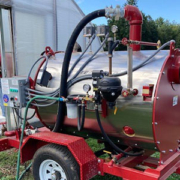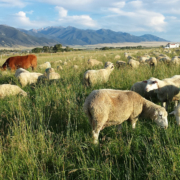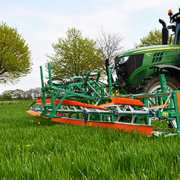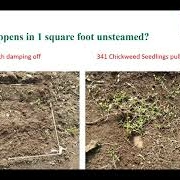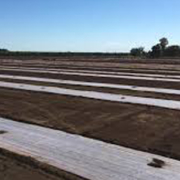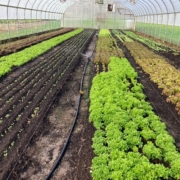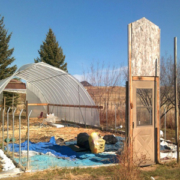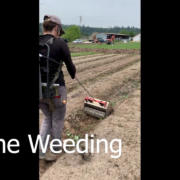Soil Steaming for Pathogen, Pest, and Weed Control in High Tunnels
 Print This Post
Print This Post
By Andy Pressman and Chris Lent, NCAT Sustainable Agriculture Specialists
Bruce and Jenny Wooster operate Picadilly Farm in southwestern New Hampshire along the Connecticut River. Listening to Bruce talk about the farm gives a sense of how much they care about the ecology and natural beauty of the land, as well as the farm’s place in the agricultural history of the region. With a large CSA, on-farm store, and deliveries to local restaurants and co-op, Bruce, Jenny, and all who work on this certified organic farm are very busy. So, finding ways to be more efficient is important, especially in finding appropriate technologies to implement. One of the technologies they’ve implemented is soil steaming—an emerging technology for managing disease, weeds, and pests in the soil.
Many parts of the country have been using steam as a solution for managing soil; however, this practice is not widely adopted in the Northeast. This is in part due to the high cost of the equipment used for soil steaming, which is a deterrent for small and medium-scale farms that represent the bulk of vegetable and fruit growers in the region. There is also the need for further research to help farmers better understand the effectiveness steaming has, not only on pests, disease, and weeds, but also on the beneficial organisms living in the soil.
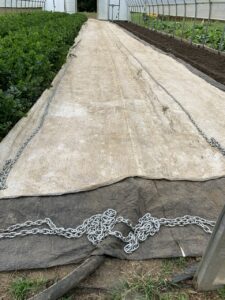
Bed ready to be steamed. Photo: Andy Pressman, NCAT
To help address these challenges, the Cheshire County (NH) Conservation District (CCCD), along with NCAT, the University of New Hampshire Cooperative Extension, and Picadilly Farm, are working together to better understand soil steaming in high tunnels. The project is being funded through a USDA-Northeast Sustainable Agriculture Research and Education (SARE) grant. Through the grant, CCCD has acquired a soil steamer that is now part of its equipment rental program for growers. The project partners are providing training for farmers that include on-farm demonstrations and the facilitation of peer-to-peer learning on the best practices for soil steaming.
The goal of soil steaming is to pasteurize the soil, not to sterilize it. The learning curve for soil steaming at Picadilly Farm is to use steam to help manage weeds in their high tunnels. Their methods for steaming are the result of what they learned from other farms that have some experience with soil steaming, as well as some trial and error. The ground that is to be steamed is fully prepared for planting and is irrigated to moisten the soil. This allows for minimal soil disturbance between steaming and crop planting so that no new weed seeds are pulled to the surface after steaming has occurred. A hose, also called a sock, is placed down the center of a planting bed, and a tarp is placed over the 5 x 96-foot area with long sections of 3/8-inch chains used to hold down the edges of the tarp. Walking on top of the chain to imbed the tarp slightly into the ground can help seal the edges and hold in more steam.

The low-pressure steamer set up and leveled outside a high tunnel at Picadilly Farm. Photo: Chris Lent, NCAT
The tarp material can vary from used greenhouse plastic to silage bag material, which is what Bruce uses. To start the steaming process, a valve is opened on the low-pressure boiler unit, which produces steam at 3 to 4 psi and is fed through the sock under the tarp. The sock is made of a material that weeps steam into the space below the tarp and begins to heat the area. Depending on conditions, the tarp will billow up and fill with steam, reaching temperatures of 140° to 160°F or higher, within a few hours. Piccadilly Farm has had success in controlling chickweed by holding the temperature at 160°F for 30 minutes. Fungal and bacterial pathogen control has occurred at temperatures of at least 140°F for 30 minutes. Other farms that have experimented with this system report control of chickweed and soilborne pythium (damping off) at 140°F. If the temperature gets too hot, the steam can kill beneficial nitrifying bacteria.

Photo: Andy Pressman, NCAT
The boiler unit itself is stationed just outside the high tunnel and is powered by a diesel burner that generates the heat. A good water source is needed to initially fill the water tank on the steamer and a source of 110V electric, the same as household voltage, is needed to run a blower and the few other electrically controlled components on the unit. Wooster has found that the unit uses about four gallons of fuel an hour. If all goes well, he can set up the boiler, sock, and tarp, and steam one bed in about two hours. However, there are many factors, such as soil moisture and ambient air temperature, that can affect the length of time it takes to get up to an effective temperature under the tarp.
According to Becky Maden, University of Vermont Extension, soil temperatures held at 180°F for 30 minutes will control most weed seeds and most plant pathogenic fungi and bacteria. On the other hand, these temperatures may also affect soil insects and some of the beneficial biological life in the soil. As a result of the decay of soil biology after steaming, a nitrifying effect is seen in the weeks following steaming that can give a boost to the subsequent crop. Maden emphasizes that more research is needed before conclusions can be made about the depth and breadth of the effects of soil steaming on soil biology.
Related ATTRA Resources:
ATTRA Video: Soil Steaming for High Tunnels
Other Resources:
The Ag Engineering Podcast: Soil Steaming for Weed Control: EP61
This blog is produced by the National Center for Appropriate Technology through the ATTRA Sustainable Agriculture program, under a cooperative agreement with USDA Rural Development. ATTRA.NCAT.ORG.

